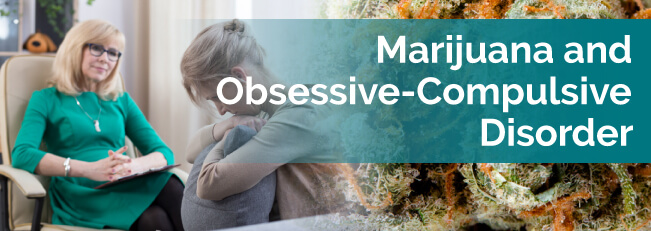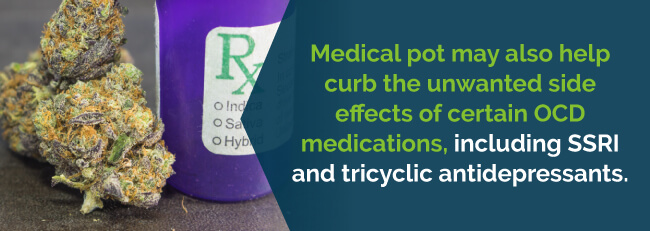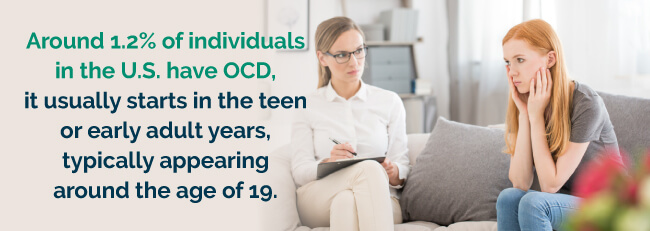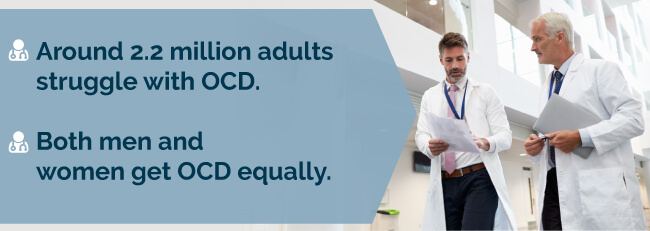
Finding the right treatment for obsessive-compulsive disorder (OCD) can be difficult. Doctors often turn to anti-anxiety and antidepressant medications, which come with a whole lot of side effects. It’s no wonder why there’s a growing interest in medical marijuana for obsessive-compulsive disorder. That’s because marijuana can play a helpful role in treating OCD.
Medical professionals have yet to determine the cause of OCD. Some theories focus on physical trauma or infections that lead to changes in the brain, while others focus on emotional trauma that led to the inability to cope. Traditional treatment for someone suffering from OCD combines extensive cognitive therapy with selective serotonin reuptake inhibitor (SSRI), or tricyclic anti-depressants and anti-anxiety medications.
Learning to manage OCD can take years of intensive therapy, depending on how severely the disorder manifests itself. For someone who has been all but debilitated by the disorder, prescription medications often help manage the anxiety and depression associated with the disorder to give the therapy time to work. While many anti-depressants and anti-anxiety medications can be effective, they frequently come with severe negative side effects.
Among the more common negative side effects are nausea, headache, agitation, diarrhea, weight gain, insomnia and drowsiness. Anti-anxiety drugs, which work by slowing down brain activity, also come with a long list of potential side effects, including drowsiness, confusion, impaired thinking, blurred vision, memory loss and even depression.
Given the long list of common negative side effects that accompany anti-depression and anti-anxiety medications, you can consider the use of medical marijuana as an alternative treatment option. Medical marijuana offers many of the same benefits of the prescription drugs, without the negative side effects.
Medical practitioners around the world have used marijuana to treat both pain and anxiety for centuries. Recent studies have confirmed medical marijuana is an effective medication for some people suffering from anxiety-related disorders. Although some study participants reported increased anxiety in recent studies, many reported a significant decrease in anxiety-related symptoms when using medical marijuana. Researchers believe the disparate results are based on individual body chemistry.
Conventional SSRI medications work by producing a brain chemical known as serotonin. While medical marijuana does not produce serotonin, marijuana does affect a brain substance known as anandamide. When anandamide reacts with the THC found in marijuana, it produces a calming or soothing effect throughout the body, which can decrease the anxiety felt by an OCD sufferer. By reducing anxiety, the compulsive urges associated with the disorder often diminish.
Studies have also shown medical marijuana is an excellent anti-nausea drug. For an OCD patient who continues to need some of the traditional medications, the addition of medical marijuana can alleviate some of the negative side effects. Cannabidiol, or CBD, is one of the major components of medical marijuana. Clinical studies have shown CBD contains chemical properties that not only reduce anxiety, but also alleviate nausea.
OCD takes on different personas in different individuals. Medical cannabis for obsessive-compulsive disorder may either be helpful to you or not, depending on your unique way of doing things. Some individuals with OCD who use medical marijuana feel like they aren’t in control, while others find a great deal of much-needed peace with it during moments of high anxiety or stress.
Medical cannabis has been helping treat anxiety for a long time. In particular, CBD has anti-anxiety properties, and many patients are using high-CBD products to help control their OCD symptoms.
Even so, anxiety comes in different forms. One patient who suffers from post-traumatic stress disorder may experience anxiety differently than another patient who struggles with social anxiety, which is also true for OCD patients.
Each OCD patient has unique experiences and obsessive thoughts that trigger worry and anxiety. And the only way these people can find relief for their anxiety is by acting out their compulsions.
At some point in our lives, we’re all going to question whether we locked the front door of our home. But most people can go on with their day regardless of not knowing, and eventually forget about it until they return home. With OCD patients, however, not knowing if they locked their front door can often cause their anxiety levels to spike considerably if they’re not able to act out their compulsions — in this example, checking the front door multiple times.
As mentioned above, OCD can cause a variety of symptoms. Thankfully, cannabis and obsessive-compulsive disorder treatment can help with most of these symptoms, including:
Medical pot may also help curb the unwanted side effects of certain OCD medications, including SSRI and tricyclic antidepressants, such as:

Best Strains of Marijuana to Use for Obsessive-Compulsive Disorder
Strains are an important factor when choosing to take cannabis. There’s a broad world of medical marijuana with a lot of options available to you. Marijuana for obsessive-compulsive disorder is no different.
While one OCD patient may find success with a THC-dominant strain, another patient may feel uncomfortable with this type of strain. If this is the case with you, a CBD-rich strain may be what you need.
As a medical pot patient, the best thing you can do when trying marijuana and obsessive-compulsive disorder therapy for the first time is to determine whether you will respond better to THC-dominant strains or CBD-dominant strains. With anxiety disorders like OCD, you may want to select a CBD-dominant strain over a powerful THC strain at first. However, THC does have anti-anxiety effects, so these strains can be beneficial.
Also, when consuming cannabis for obsessive-compulsive disorder, you’re getting some terpenes and cannabinoids in addition to THC.
Terpenes are the aroma and flavor compounds in marijuana resin. Cannabinoids are the plant’s active compounds that engage your body’s cell receptors. Both have anxiety-fighting properties.

Research shows that both terpenes and cannabinoids help balance THC’s uncomfortable effects. And when you’re struggling with OCD, this balance could be extremely beneficial.
Let’s take a look at some mild THC strains. These may include:
If a THC strain doesn’t work for you, you may need to try a CBD-dominant strain. Research shows CBD is a successful OCD treatment.
CBD treatment helps reduce stressful event-induced anxiety such as public speaking, for instance, if you take the treatment before the event. Information like this is good to know when you’re about to do something that could aggravate your obsessive, compulsive and anxious tendencies.
There’s more to strains than THC and CBD. You’ll want to explore Indica and Sativa strains, too. However, if you’re just starting out with medical cannabis for obsessive-compulsive disorder, you’ll probably want to begin with an Indica strain over a Sativa, since Sativa strains produce brain-focused, cerebral effects.
These effects sometimes cause paranoia and are more anxiety-provoking. Sativa strains are stimulating, similar to drinking a strong cup of java. People with serious anxiety issues may wish to avoid Sativa strains, though these strains are typically fine for very mild cases of anxiety. Again, you’ll want to test out different strains to see for yourself.
Indicas have different effects than Sativas. With a true Indica, you’ll feel the effects mostly as a relaxing and general slowing down of your body. Indicas are an excellent choice if you’re looking for an all-around mellow time.
If your OCD causes severe anxiety, a few potentially helpful strains you can try include:
These strains are good for OCD patients due to their cannabinoid profiles.
A couple of strains that help improve quality of life in OCD patients include:
If you’re just starting marijuana and obsessive-compulsive disorder therapy, pay particularly close attention to how each strain impacts your OCD. Always start off with a low dose and work your way up.
Just like trying out different strains to see what works best for you and your OCD, trying different methods of medical marijuana consumption is a good idea as well.
Some methods of use are better than others for OCD symptom relief. You’ll probably not feel a whole lot of benefit from applying cannabis topically to your skin, for instance. You have room to experiment, however, since there are several ways to consume your weed. Some ways you may want to try for your OCD include:
Probably the healthiest method of consumption would be treating your medical cannabis like it’s a vegetable. Add a few fresh cannabis leaves to your smoothie — blended, of course, to combine the benefits of medical pot with other foods, so you’re taking advantage of all nutrients.
Talk to your doctor or dispensary budtenders to get advice on using your marijuana for OCD. Only they can advise you on proper marijuana usage for your obsessive-compulsive disorder, including the recommended dosage, strain and more. Search our database for a dispensary and marijuana doctor in your area today.
Find A Doctor Find A Dispensary
OCD is a type of anxiety disorder where you have unwanted, recurring thoughts, sensations, obsessions or ideas that drive you to do something repetitively and compulsively. These compulsions or repetitive behaviors, which include things like continuously cleaning, checking on things or hand-washing, can significantly interfere with your social interactions and daily activities.
Many individuals have repeated behaviors or focused thoughts that don’t interfere with their daily life, and that may even make tasks easier for them. However, individuals with OCD suffer from an avalanche of unrelenting and persistent thoughts. They have unwanted behaviors and fixed routines, and when they don’t do them, it causes them lots of distress and anxiety.
Many OCD patients suspect or know their obsessions are unwarranted. Others think their obsessions are appropriate. Regardless, individuals with OCD find it difficult to keep their focus and attention off their obsessions, and they can’t stop their compulsive actions.
To get an OCD diagnosis, your presence of compulsions and/or obsessions must be time-consuming — more than an hour daily. The compulsions must cause you immense anguish and impair your social interactions, work, school or other important functions.

Around 1.2 percent of individuals in the U.S. have OCD, and slightly more females experience it than males, according to the American Psychiatric Association. Also, OCD usually starts in the teen or early adult years, typically appearing around the age of 19.
Customarily, an individual’s OCD falls into one of these four areas:
These are the common forms of OCD and its associated fears, though this isn’t an exhaustive list.
Before psychological treatments came about, our ancestors thought OCD and other anxiety disorders were spiritual problems. Individuals who brought too much attention to themselves were punished with persecution and imprisonment or had misguided, brutal experiments done to them.
Modern OCD concepts started evolving in the 19th century, when phrenology, faculty psychology and mesmerism were well-known theories and when “neurosis” indicated a neuropathological disorder. Gradually, psychologists differentiated obsession from delusion, and compulsion from impulsion. Influential psychiatrists argued about whether the source of obsessive-compulsive disorder lay in disorders of the emotions, the intellect or the will.
Researchers suspect OCD incidences are on the rise. However, epidemiological studies nationwide are limited. Findings from one study suggest there’s been an increase in the treatment incidences of OCD.
OCD normally includes both compulsions and obsessions. However, it is possible for you to have symptoms of only compulsion or symptoms of only obsession. You might not even realize your compulsions and obsessions are unreasonable or excessive, despite the fact they’re affecting your work or social functioning, taking up a great deal of your time or interfering with your daily routine.
OCD obsessions are intrusive, persistent, repeated and unwanted urges, thoughts or images that cause anxiety or distress. You may try to eliminate them by performing a particular compulsive ritual or behavior, or you may try to ignore them altogether, typically without much success. Obsessions tend to intrude when you’re trying to do or think of other things.
OCD compulsions are repeated behaviors that drive you to perform them. In an OCD sufferer’s mind, repetitive behaviors will prevent bad things from happening or reduce or prevent anxiety that’s related to obsessions. But when you engage in your compulsions, you don’t feel any pleasure out of it, other than a temporary relief from your anxiety.
You might make up rituals or rules you can follow to help keep your anxiety under control when you’re experiencing obsessive thoughts. The compulsions are needless and excessive, and usually aren’t realistically related to the problem you’re trying to fix.
OCD tends to cause extreme discomfort. When OCD is severe, it can dramatically interfere with your everyday life and cause excessive amounts of distress. If you’re struggling with OCD, you may feel exceptionally emotional and anxious. You may also experience non-OCD symptoms, such as:
The longer you struggle with OCD and its effects without getting help, the more out-of-control and powerless you’ll feel. Feeling this way can lead to degraded self-esteem and depression. Both the exhaustion and pressure make it hard to interact socially with others, leading to loneliness and isolation.
OCD effects can cause turmoil in your life. The compulsions and obsessions can eat up much of your day, and this interferes with your social activities, work, and family life.

Obsessive-Compulsive Disorder Statistics
According to the Anxiety and Depression Association of America:
Acting out your compulsions is likely not a pleasurable thing. Instead, these actions may offer a brief relief from the anxiety obsessive thinking causes. Doctors typically treat OCD with a combination of medications — anti-anxiety drugs and antidepressants — and psychotherapy.
Cognitive-behavioral therapy is the typical OCD treatment with the most research supporting its effectiveness. There are two components to cognitive-behavioral therapy:
1. Cognitive therapy
2. Exposure and response prevention
The cognitive therapy component for OCD focuses on the exaggerated sense of responsibility and catastrophic thoughts you feel. A huge part of OCD cognitive therapy is teaching you effective and healthy ways to respond to your obsessive thoughts, instead of turning to your compulsive behavior.
This component of treatment involves exposing you to your source of obsession repeatedly. Your doctor will then ask you to resist whatever compulsive behavior you would normally perform to decrease your anxiety.
For instance, if you wash your hands compulsively, the therapist may ask you to touch the handle of a door in a public restroom and then prevent you from being able to wash your hands afterward. You’ll sit with the anxiety until the urge of washing your hands dissipates.
With this approach, you’ll eventually learn you don’t require the ritual to eliminate your anxiety, and that you can control your obsessive thoughts and compulsive behaviors to some extent. Exposure and response prevention for OCD helps “retrain” your brain and reduces the occurrence of your OCD symptoms permanently.
Along with cognitive-behavioral therapy, other OCD treatments include:
Friends and family members can play a significant role in your outcome. Their reaction to your OCD has an immense impact. Your OCD can get worse with criticism and negative comments, while it can improve with support, praise and providing a calm environment for you.